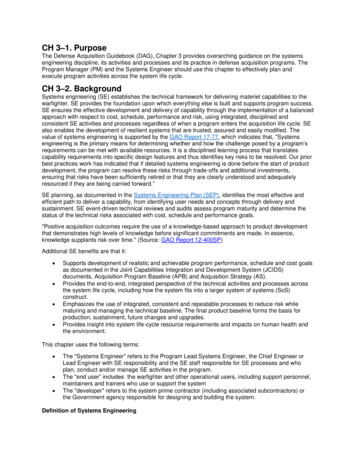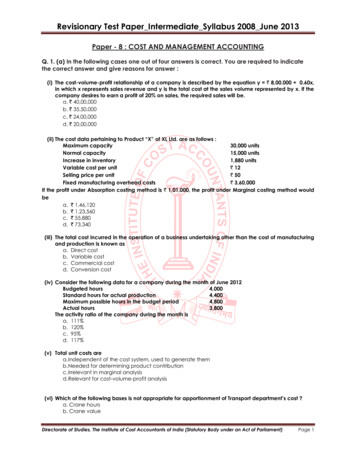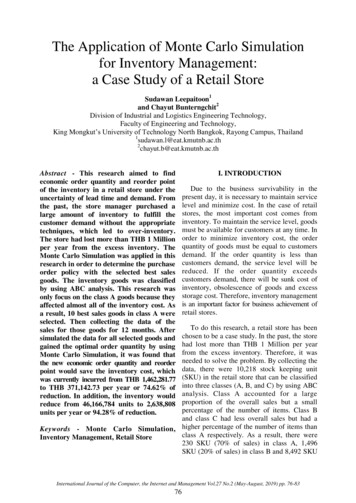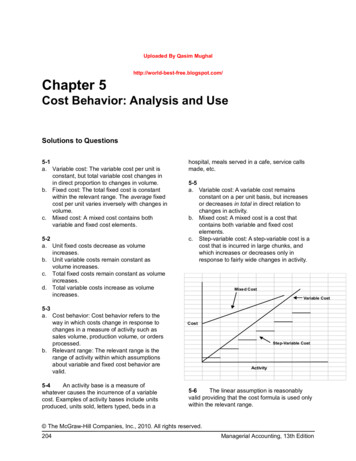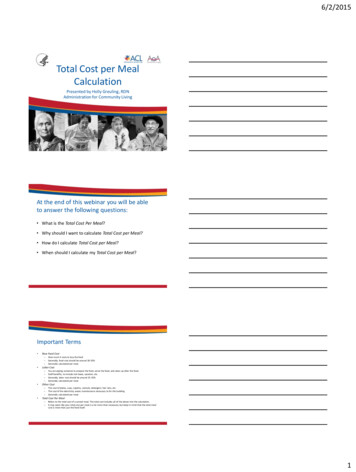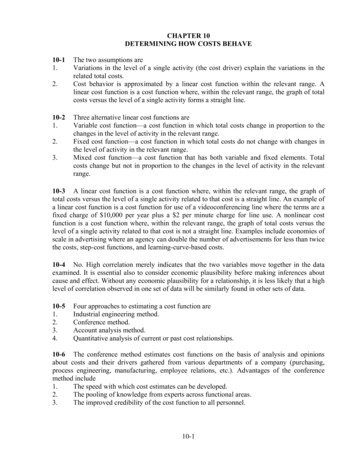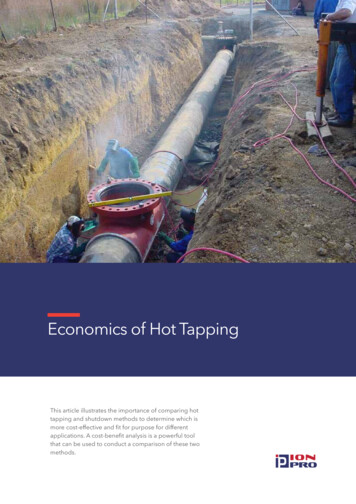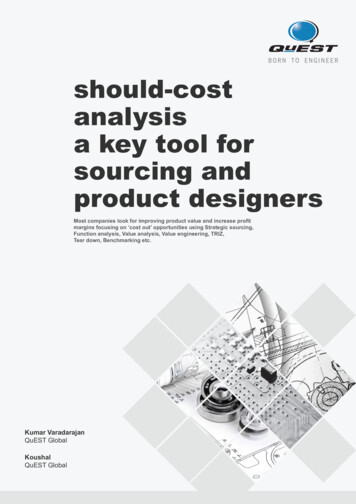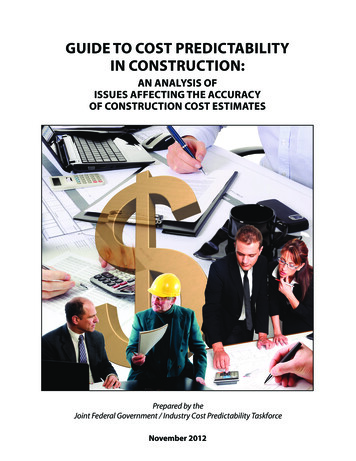
Transcription
Guide to Cost Predictabilityin Construction:An analysis ofissues affecting the accuracyof construction cost estimatesPrepared by theJoint Federal Government / Industry Cost Predictability TaskforceNovember 2012
Guide to Cost Predictability in Construction: An Analysis of Issues Affecting the Accuracy of Construction Cost EstimatesNovember 2012Table of ContentsNote from the Taskforce Chairman . . . . . . . . . . . . . . . . . . . . . . . . . . . . . . . . . . . . . . . . . . . . . . . . . . . . . . . . . . . . . . . . . . . . . . . . . . . . . . . . . . . . . . . . . . . . . . . . . . . . . . . . . . . . . . . . . . . . . 1Executive Summary. . . . . . . . . . . . . . . . . . . . . . . . . . . . . . . . . . . . . . . . . . . . . . . . . . . . . . . . . . . . . . . . . . . . . . . . . . . . . . . . . . . . . . . . . . . . . . . . . . . . . . . . . . . . . . . . . . . . . . . . . . . . . . . . . . . . . . . . 2Taskforce Participation. . . . . . . . . . . . . . . . . . . . . . . . . . . . . . . . . . . . . . . . . . . . . . . . . . . . . . . . . . . . . . . . . . . . . . . . . . . . . . . . . . . . . . . . . . . . . . . . . . . . . . . . . . . . . . . . . . . . . . . . . . . . . . . . . . . . 3Introduction to the Cost Predictability Issue . . . . . . . . . . . . . . . . . . . . . . . . . . . . . . . . . . . . . . . . . . . . . . . . . . . . . . . . . . . . . . . . . . . . . . . . . . . . . . . . . . . . . . . . . . . . . . . . . . . . . . . . . . 4Issues and Considerations in Cost Predictability . . . . . . . . . . . . . . . . . . . . . . . . . . . . . . . . . . . . . . . . . . . . . . . . . . . . . . . . . . . . . . . . . . . . . . . . . . . . . . . . . . . . . . . . . . . . . . . . . . . . . 6Cost Estimate Variance Matrix. . . . . . . . . . . . . . . . . . . . . . . . . . . . . . . . . . . . . . . . . . . . . . . . . . . . . . . . . . . . . . . . . . . . . . . . . . . . . . . . . . . . . . . . . . . . . . . . . . . . . . . . . . . . . . . . . . . . . . . . . . . 9Recommendations for Improved Cost Predictability . . . . . . . . . . . . . . . . . . . . . . . . . . . . . . . . . . . . . . . . . . . . . . . . . . . . . . . . . . . . . . . . . . . . . . . . . . . . . . . . . . . . . . . . . . . . . . 10Postscript . . . . . . . . . . . . . . . . . . . . . . . . . . . . . . . . . . . . . . . . . . . . . . . . . . . . . . . . . . . . . . . . . . . . . . . . . . . . . . . . . . . . . . . . . . . . . . . . . . . . . . . . . . . . . . . . . . . . . . . . . . . . . . . . . . . . . . . . . . . . . . . . . . 11Appendix 1 – Classes of Estimates . . . . . . . . . . . . . . . . . . . . . . . . . . . . . . . . . . . . . . . . . . . . . . . . . . . . . . . . . . . . . . . . . . . . . . . . . . . . . . . . . . . . . . . . . . . . . . . . . . . . . . . . . . . . . . . . . . . . 12Appendix 2 – Documents Recommended for Estimates . . . . . . . . . . . . . . . . . . . . . . . . . . . . . . . . . . . . . . . . . . . . . . . . . . . . . . . . . . . . . . . . . . . . . . . . . . . . . . . . . . . . . . . . . . 14Appendix 3 – Qualifications for Estimators and Cost Consultants. . . . . . . . . . . . . . . . . . . . . . . . . . . . . . . . . . . . . . . . . . . . . . . . . . . . . . . . . . . . . . . . . . . . . . . . . . . . . . 21Appendix 4 – Sources of Information and References. . . . . . . . . . . . . . . . . . . . . . . . . . . . . . . . . . . . . . . . . . . . . . . . . . . . . . . . . . . . . . . . . . . . . . . . . . . . . . . . . . . . . . . . . . . . . 24Enquiries should be directed to:Canadian Construction Associationwww.cca-acc.comThis guide is the product of the individual taskforce members’ collective input and does not purport to express or representthe position of their respective organizations or associations. It reflects recommended industry practices. Readers arecautioned that this guide does not deal with any specific fact situation or circumstance. This guide does not constitutelegal or other professional advice. The taskforce and their respective organizations or associations do not accept anyresponsibility or liability for loss or damage which may be suffered as a result of its use or interpretation.Copyright 2012Must not be copied in whole or in part without the written permission of the Joint Federal Government / Industry CostPredictability Taskforce.
Guide to Cost Predictability in Construction: An Analysis of Issues Affecting the Accuracy of Construction Cost EstimatesNovember 2012Note from the Taskforce Chairmanassociated degree of accuracy of the estimate can beexpected to vary accordingly.What at first appeared to be a relatively simple task toreview the various and mostly obvious causes of poorcost predictability increasingly grew in each taskforcemeeting as more and more variables were raised andreviewed. As the topics for consideration ranged fromfirst bid comparison, whether low, median or average, tocost growth during construction, to final project cost, andeven whether to review various “soft costs” to the extentthat they may have an effect on cost predictability, etc.,it soon became apparent that a clear and rigid definitionof the scope of the taskforce had to be established.This would limit the discussions to achieve definablerecommendations relating to the original rationale forthe taskforce, which was to analyze the increasingly largevariances being experienced by PWGSC, DCC, and othersbetween their “pre-tender estimate” and the subsequentcontractors’ bids.For this reason the taskforce concluded that the previouslyaccepted degree of accuracy for Class A estimates shouldbe expanded from /- 5% to a range of /- 5 to 10%, toaccommodate the range of such non-standard projects,with a similar variation applied to the other classes ofestimates. As well, for projects involving significantrenovations, or challenging geographic, environmental, orother unique circumstances, a further allowance should beanalyzed and included.In addition, whereas the previous cost predictabilityguidelines were related primarily to the degree of designdevelopment completion, it became obvious that with theincreasing variety and complexity of various projects, thepotential accuracy of estimates must equally recognizethe relationship to the level of complexity of any particularproject, or its level of estimating difficulty. For this reason, aCost Estimate Variance Matrix was developed, to recognizethe combination of both these dimensions in arriving at areasonable estimate variance.The basic question whether such increasing variancesare the result of the construction industry’s “pricingstrategies”, or of an inaccurate or insufficient estimatingprocess, was soon concluded to be the latter, since withfew exceptions, under a normal and competitive biddingprocess actual bid prices are generally the best indicator ofthe prevailing competitive market conditions for a specificproject at that time. Upon further review it was also foundthat the owners’ estimating process was seldom properlycompleted up to a reasonable Class A level, and in mostcases only up to Class B, or even a brought forward Class C!Finally, since estimating and bidding is not an exactscience, the expectation for estimate accuracy must berealistic, in relation to the particular type of project and inproportion to the quality and time expended to producea specific level of estimate accuracy. But at any level,adherence to the recommendations of this guide shoulddefinitely improve cost predictability.In this respect it bears repeating the obvious, that toachieve a realistic Class A estimate requires the followingingredients:Also, it must be recognized that each project is uniqueand different from the previous one in varying degrees.Although many projects may be relatively repetitive and“similar”, such as “standard” office buildings or schools,many others are non-standard and individually complex,unique, one-of-a-kind, remotely located, etc., or anycombination thereof, such as leading edge lab facilities,historic building renovations, environmentally challengedlocations and increasingly green, sustainable, and moreinnovative structures and systems.1. Class A professional and experienced estimatingqualifications;2. Class A completed project design documentation; and3. Class A time, sufficient to produce the required estimateanalysis with accuracy.Lastly, the taskforce was fortunate to have the benefit ofsenior, experienced, informed, articulate, and independentcross-sector representatives; I sincerely want to thank eachof them for their effective and dedicated participation inthe production of this guide.Further, since the preparation of project estimates hastypically been based on historical information, suchinformation may be outdated, or perhaps not even existfor certain individual types of projects; therefore, the1
Guide to Cost Predictability in Construction: An Analysis of Issues Affecting the Accuracy of Construction Cost EstimatesNovember 2012Executive Summary Large discrepancies between pre-tender estimates andactual bids for construction have a serious impact onthe viability of a project. Owners, architects, engineers,cost consultants, contractors and subcontractors allhave a vested interest in ensuring a high degree of costpredictability. This issue, raised at the Federal Government/ Industry Real Property Advisory Council, resulted in theformation of a Cost Predictability Taskforce, to research andrecommend solutions to this increasing problem.recognize the degree of accuracy of the estimate beingused.A large number of factors contribute to variances inestimate to bid prices. This guide will provide practicaladvice and discuss the primary ways to improve the costpredictability of projects. The consequence of a failure isoften a cancelled project.The Cost Estimate Variance MatrixAs shown in the Cost Estimate Variance Matrix, theaccuracy of estimates varies throughout the project designcycle and according to the complexity of the specificproject, and several other factors that may be unique toa project. Depending on the class of estimate and thecomplexity of the project, variances can range from 5% to30%. If additional unique aspects or risks apply to a project,these variances should be analyzed and increased by anappropriate amount.Defining Cost PredictabilityFor the purpose of this guide, “cost predictability” isdefined as “the prediction of a construction cost estimate,as compared to the median of competitive bids”, where“prediction” is defined as “an assertion on the basis of data,theory or experience, but in advance of proof”.As such this guide will apply only to procurementprocesses that typically require the submission of a totalproject bid, such as a design-bid-build or design-buildprocess, and although not directly applicable to theconstruction management process, it could also be appliedto the sequential trade contractors’ bids.Improving Cost PredictabilityEarly in the project life cycle, i.e., before the requirementsare well-defined and before accurate estimates areavailable, owners will need to set budgets. The challengefor all stakeholders is to ensure that the appropriate scopeand cost management framework is adopted to ensurethe desired, or required, degree of cost predictability. Thefollowing recommendations should be considered toimprove the cost predictability between the final pretender estimate and actual bid prices:Similarly, many of the same underlying principles couldalso be applied to the further development of costpredictability guides for the increasing range of P3 andlease/purchase procurement process variations.Taskforce AnalysisThere is no common statistical database on variancesbetween pre-tender estimates and final bid results forthe Canadian construction market. However, membersof the task force shared internal data that showed upto 40% of tenders had low bids that varied, either up ordown, by more than 30% from the pre-tender estimateand fewer than 20% of tenders had bids within 10% ofthe estimate. While this was not the case with all of thetaskforce members, all agreed that cost predictability wasan increasingly serious issue facing the industry.Before Tender include sufficient contingency to address marketvolatility, timing of construction, and other exclusions inthe estimate;It was agreed that the following key actions are required toensure better cost predictability:During Tender keep the cost consultant involved during the tenderperiod; consider possible scope variations in the tender as acontingency to adjust to the owner’s budget; give designers sufficient time to finalize 100% biddocuments for the pre-tender estimate; and allow cost consultants or estimators sufficient time toprepare and finalize pre-tender estimates. engage qualified professionals to prepare estimates; use appropriate economic models in the estimatingprocess; monitor addenda changes and bidding environment;and ensure that the project approval process recognizescost predictability issues; revise estimates to reflect scope changes and addenda. After Tender involve the cost consultant in the post tender review;include scope revision mechanisms in the projectapproval process; and2
Guide to Cost Predictability in Construction: An Analysis of Issues Affecting the Accuracy of Construction Cost EstimatesNovember 2012 analyze bid results against estimates for lessonslearned; consider value engineering to improve bid versusestimate variations; and keep a record of historical estimate versus bid data.Taskforce Participation*ChairmanJohn Westeinde, P.EngPresidentWesteinde Construction Ltd.ArchitectAlexander Rankin, OAA FRAIC ARIBA MRIAI FCDBI RCAPartnerGRC ArchitectsCost Predictability GuaranteeThere is no guarantee that pre-tender estimates willprecisely match bid prices, just as there is no expectationthat all bid prices will be the same. In reality, there are toomany variables influencing final bid prices to expect 100%accuracy. However, following the recommendations in thisguide will help improve and define the cost predictabilityof projects.EngineerMichael Allen, P.EngPresidentAdjeleian Allen Rubeli LimitedCost ConsultantArt MawPresidentHanscomb LimitedContractorSpencer Hagan, P.Eng GSCDistrict Construction Risk ManagerPCL Constructors Canada Inc.Public Works and Government Services CanadaShawn GardnerSenior Director, AFD Directorate, Acquisitions BranchDefence Construction CanadaRon deVries, P.EngSenior Vice President, OperationsMichael FreemarkSenior Technical AdvisorCanadian Museum of NatureMaria K. Somjen B.Arch. LL.B. (on leave from PWGSC)Project Director, VMMB Renewal ProjectCanadian Construction AssociationEric LeeSenior Director, Industry Practices* NOTE: The positions and titles of the taskforce members are those whichthey held during the earlier development of this guide, and may havechanged by the time it went to print.3
Guide to Cost Predictability in Construction: An Analysis of Issues Affecting the Accuracy of Construction Cost EstimatesNovember 2012Introduction to the Cost PredictabilityIssuethe final cost. As well, such factors as occasional mistakes(large or small), aggressive or conservative biddingfor individual bidders’ reasons, misinterpretations ormisunderstandings of the bid documents, and various riskcontrol procedures also play a significant role in the finaloutcome.The problem of cost predictability was introduced byPublic Works and Government Services Canada (PWGSC) atthe joint Government of Canada / Canadian ConstructionAssociation (CCA) meeting in April 2003, where thedepartments identified a need to improve the accuracyof its pre-tender construction estimates (Class A estimate)which were increasingly resulting in variances of greaterthan 30% from the bids received. This issue was delegatedto the Project Delivery Working Group of the FederalGovernment / Industry Real Property Advisory Councilfor action and it was concluded that the problem of costpredictability was a generic problem, not only on federalgovernment projects, but also for private industry projects.Therefore, it was subsequently decided to establish aseparate taskforce to review this issue to:Bid closing involves an amalgam of prices being receivedby several individuals within each firm that must beevaluated and entered, the majority of which takes placewithin the last one-half hour period before bid closing,with major decisions happening up to the final minutesand seconds. Meanwhile, similar processes happen at themulti subcontractor and supplier levels. analyze the problems inherent in the cost predictabilityprocess;In addition, local or national construction industries arebecoming increasingly affected by global trends andinfluences, which can create significant and unexpectedvolatility and unpredictability in the constructionmarketplace. Recent examples of such market volatilitywould include: review procedures to improve cost predictability; develop a guide paper with recommendations toimprove cost predictability; andThe volatility in the 2004 marketplace relating tostructural steel and all steel-based commodity pricing. develop procedures to monitor future costpredictability improvements over an initial five yearperiod.The abnormal cost escalation in BC during 2006 leadingup to the Vancouver Olympics. The unprecedented run-up in almost all constructionmaterial prices in 2008, especially for steel and oil-basedproducts, across the world. The equally unprecedented and sudden global financialcrisis, and resulting potential temporary collapse ofboth the commodity and construction markets in 20082009.As a basic premise, the taskforce first noted that everyconstruction project is unique and different from the last.Even if some buildings or projects may appear to be similar,circumstances such as varying site conditions, seasonalweather changes, different scheduling requirements, orlocal practices, can create significant estimating and costdifferences. Even where buildings could be substantiallysimilar, such as primary schools, there is still a tendencyto redesign every next one for architectural diversity,technical advances, or other reasons.All of this volatility requires an assessment of risk on thepart of each and every contractor, subcontractor andsub-subcontractor who endeavour to strategize and planfor eventualities to establish a costing framework for theproject duration, which could be many months or years,that fits within specific corporate risk tolerance levels, whileat the same time striving to be the low bidder.In general, there is no easy way to establish consistent pretender estimates for even the most common constructionprojects that could form a reasonable market-specificand time-sensitive database for construction costs. Whilethere are cost indices available, they are only useful inestablishing utilitarian baselines, not in constructing anoverall estimate that is within 5% of the median bid.Therefore, as a result of this multi-variable bid process, it isnot uncommon to see a range of variations in contractorbid prices. Generally this range can be up to 10%; however,for smaller and one of a kind projects this range can be ashigh as 50% or more.A complete estimate is a composite of literally thousandsof individual estimate items and considerations, includingconstruction techniques, innovative ideas, site supervision,productivity factors, front-end specifications, andscheduling, etc., all of which play crucial roles in arriving atThe taskforce also found that many existing budgetingand project approval processes do not permit a sufficientdegree of flexibility to deal with large variances in bidprices. This should be internally reviewed by each owner,4
Guide to Cost Predictability in Construction: An Analysis of Issues Affecting the Accuracy of Construction Cost EstimatesNovember 2012in order to provide for sufficient organizational flexibility tobe able to mitigate the results of such potential estimatingvariances and market volatility.market considerations, and costing variables inherentin the estimating process, the taskforce has selectedthe median bid approach as the most appropriate andprofessionally attainable for comparison of pre-tenderestimates within this guide.The taskforce also needed to consider whether the pretender cost estimates should be targeted for the eventuallow contractor’s bid, which often results in the actualcontract award price, or whether it would be more prudentto target for the “median” of the various contractors’ bids,which is generally considered to be closer to the “true” costof the project.In summary, it must be recognized that given the myriadof variables that affect the contractor’s bid at any givenlocation and at any given time, it is highly problematicfor any one individual or agency, no matter how qualifiedor “in tune” with local conditions and market influences,to arrive at a consistent and accurate pre-bid estimatefor construction services. Perhaps the best that shouldreasonably be expected from such pre-bid estimates is areasonable approximation of costs that reflect the manyvariables including the size, scope, complexity, and localityof a specific project.Notwithstanding the obvious and necessary considerationattributed to the low bid value in any tendering scenario,there is a fundamental difficulty with attempting totarget the low bid as the point of comparison in a costpredictability analysis. It is almost impossible to attemptto predict the effects of particularly innovative or uniquebidding solutions on the part of individual bidders onany particular project because one or more may include:possible labour or specialized equipment advantages,locational or logistical advantages, a particularly aggressivebidding approach by anyone bidder (“this is my job”attitude), and even occasional mistakes etc. All of theseitems may combine to generate the low bid or to thecontrary, if none of these competitive bidding solutions areapplied, may result in a high bid.Nevertheless, given the significant and apparentlyincreasing variations between the bid and pre-tenderestimate, it is necessary for the industry to analyzeand improve on the various factors that affect costpredictability. Within this context, and based on anunderstanding of how this component of the industryoperates, issues and considerations are recommendedfor review and guidance during the estimate preparationprocess.In order to balance the effects of such bidding solutionswith an understanding of the myriad of logistical elements,5
Guide to Cost Predictability in Construction: An Analysis of Issues Affecting the Accuracy of Construction Cost EstimatesNovember 2012Issues and Considerations in CostPredictabilityare produced and monitored in several ways. Thereforeensure that all stakeholders and government departmentsmaintain the latest estimate provided by the costconsultant.1. Consideration of Local or Regional MarketInfluences3. Cost Estimates Should Be Prepared during TenderPeriod for Changes to Schedule or AddendaThe preparation of pre-tender estimates should considersuch specific factors as: the number of bidders on the project, and in each trade; the number of other projects being tendered at thesame time; the likelihood that certain trades will only bid to certaincontractors; complicated phasing of the project; pre-qualification of contractors; heritage issues; available time periods for tendering and construction; timing of the tender; and political mood.Request updates of the estimate during the biddingperiod. Ensure that each addendum is accompanied bya cost (and schedule) impact on the original estimatebefore the addendum is released. Ensure that the changeis acceptable to the owner and not simply a “wish” listfrom the design team or a stakeholder. Keep in mind thatschedule changes may also result in cost changes. Thisapplies particularly to the Class A estimate stage.4. Incomplete/Uncoordinated Bid Documents,Causing Different InterpretationsImprove the quality of tender documents and allowsufficient time for consultants to prepare and coordinatethem. Complete a checklist for both constructability andcoordination prior to tender. Addenda should be kept toa minimum, ideally with no more than three. Note thatuncoordinated bid documents eventually result in changeorders. Thus, past quality of tender documents could beused as criterion in the future performance evaluation ofdesign consultants.The selection of a cost consultant should be reviewed toensure previous experience with similar complexity andcircumstances of the particular project, and to reflect agreater need for additional risk analysis specifically relatedto construction hard costs.5. Failure to Recognize the Appropriate Class ofEstimateThe pre-tender estimate should show the variousinfluences that have been considered and the “factor”applied for these influences. A pre-tender estimate shouldclearly indicate what is “in” and what is “out”, and why, sothat some of the “out” items can be analyzed and added toa Risk Management Plan.An earlier, less accurate, Class C or B estimate maysometimes be passed off as the pre-tender estimate, soensure that a proper pre-tender estimate is prepared,developed from the 100% tender documents beforetendering.There is often a failure to recognize how a competitivemarketplace, or lack thereof, may affect bid prices.Cost consultants should analyze market volatility andanticipated trends. Confirm with the cost consultant thatthey have consulted with local construction associations,as well as with local contractors and/or sub-contractors,as contractors who are regularly bidding on projects arebest able to evaluate market volatility. Note that politicaldecisions can also temporarily impact the local competitivemarket.6. Fast -tracking Projects or Proceeding with a Projectbefore It Is Well DefinedWith a fixed end date, there is often a push to start workon a project long before all parameters are defined. Thismay cause a great deal of cycling, with the increasedpotential for incorrect estimates. For example, fasttracking may result in no pre-tender estimate. When it isdetermined that the estimates are wrong, the project isoften well-advanced, and therefore difficult to realign orstop. Consequently, one should allow sufficient time for thepreparation of estimates, or increase design contingenciesusing proper risk management analysis. Also, keep in mindthat different procurement methods will have an impacton project estimates.2. Current and Accurate Information Should BeShared between StakeholdersObtain concurrence from all stakeholders that the sameinformation is being used, otherwise stakeholdersmay use different numbers as reference points. Duringpublic construction projects several types of budgets6
Guide to Cost Predictability in Construction: An Analysis of Issues Affecting the Accuracy of Construction Cost EstimatesNovember 2012Including the cost estimator in the fast track stream,in which estimates are upgraded on a regular basis,will ensure that construction costs are within budgetthroughout the design and construction process bycontinuously updating the budget and estimates as thedesign progresses and true costs are identified throughthe progressive bidding process. Similarly, correspondingreductions in contingencies should be made as a resultof the continuous risk management of the project. Allmembers of the design and construction team should bekept fully informed each time the budget and resultingestimates are updated.Where cost escalation contingencies have been included,they may only refer to the bid date; this is particularlyapplicable in relation to longer duration projects. Ifpossible, shorten the time from conception to completion,or include proper allowance for labour and material priceescalation.10. Mistake of Designing to Maximum of the BudgetConstruction budgets are living documents and are veryfluid. Therefore, early budgets are identified at a very roughlevel against which the initial design is done. However, thisinitial budget should be reduced by project contingencies,etc., to more properly determine a conservative designbudget.7. Project Objectives or Program Not Clearly Definedwhen Developing the Initial Budget11. No Consideration or Misuse of Data about SimilarProjectsAllow for the redefinition of the project scope and budgetwhen project objectives or program are not clearly defined,then adjust estimates. Employ the integrated designprocess; in other words, ensure that all stakeholders haveinput from concept onward.To manage scope creep and absorb its impact:Consider the history of similar projects, including factorssuch as: the or
Guide to Cost Predictability in Construction: An Analysis of Issues Affecting the Accuracy of Construction Cost Estimates November 2012 2 Executive Summary Large discrepancies between pre-tender estimates and actual bids for construction have a serious impact on t


